Jarred Alwan
Patrick Atkins
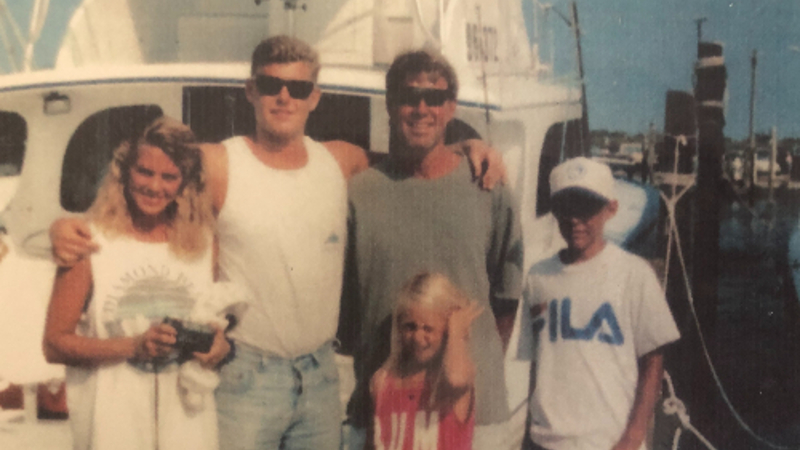
I am so grateful to the Concussion Legacy Foundation for this opportunity to share and honor Pat’s life in the Donor Gallery. It is so important to be able to communicate with an audience who understands, believes, and can empathize with the pain of the effects of CTE for all involved. One of the greatest challenges in addition to the pain, as I am sure others can attest to, is having those around you not understand and believe the disease and refuse to be educated about it. They judge your loved one about their bizarre and often damaging behaviors. The person you once knew is no longer there, and misunderstandings, isolation, and judgement abound. The amazing work of the wonderful researchers, doctors, and team members at Boston University, the Concussion Legacy Foundation, and the VA are not only helping prevent future generations from this debilitating disease, but provides comfort and understanding for those family members and friends left behind.
My husband “Pat” was one of six children, born fourth in line, to a loving, hardworking Irish Catholic family in Peoria, Illinois. Pat, who had always been athletic, outgoing, smart, but somewhat of a rebel was perfect for competitive sports. At a young age, according to his siblings, Pat was always on the go, playing neighborhood baseball, memorizing stats, and combing over the newspaper sports’ pages. One of his favorite memories was attending a Chicago White Sox game with his dad. The tickets and trip which they could not have been able to afford was given to Pat by a scout who was impressed by Pat’s knowledge of the games and players he was observing just one afternoon on the bleachers – Pat was ten years old. Pat’s dad nurtured his love of sports and the comradery Pat experienced at his grade school through high school teams were irreplaceable and lasted throughout his lifetime. He loved his teammates and the game of football. His high school teammates from his undefeated Spalding High School team were his best and most loyal friends until Pat passed away in 2019. His high school football success gave Pat the opportunity to be the first in his family to graduate from college when he received a scholarship to the University of Wyoming.
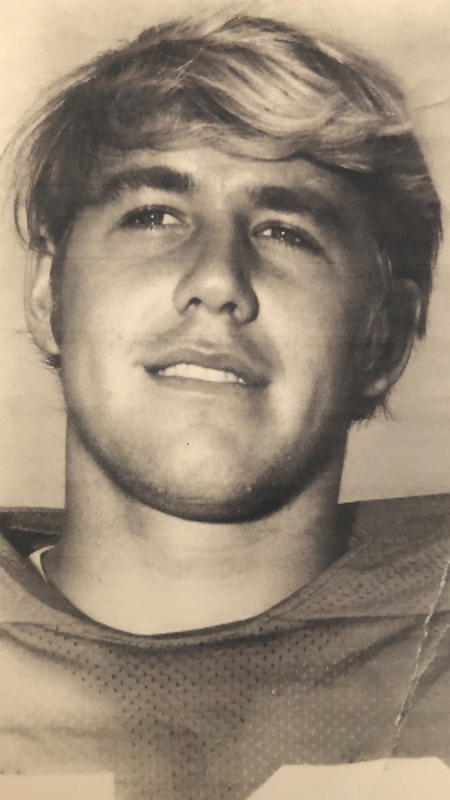
His junior year, Pat transferred to Illinois State University where we literally met on the Redbird football field. I was a cheerleader and he whispered to one of his teammates, “I am going to marry that girl.” He did! He had caught my eye as well, and two years later we were married.
Thus began our life in Peoria, Illinois. After graduation from ISU, I became a special education teacher. Pat worked a couple of jobs until he found his niche as a State Farm Insurance Agent. Pat loved serving people and meeting their needs. He built his business from the ground up. I still remember him making cold calls on a little card table set up in our basement. Pat loved people and his outgoing, fun-loving personality served him well in this occupation and he became a successful State Farm Agent. For 30 years, he was able to provide a generous and beautiful life for our three children and me. Pat was a wonderful family man and was so supportive of everything our three, very active children did. He loved coaching Little League for the boys for years, and I don’t think he ever missed a game throughout their high school years or any of our daughter’s dance performance. Pat loved God and his family. He was active at church for many years and always put his wife and children first. He was very selfless about doing things for himself but took good care of his body by playing softball, running, exercising, and occasionally golfing with his fellow insurance agents. He provided us with lovely vacations at the beach, which he loved. Pat also loved music and writing and shared that appreciation with our children. I am so grateful for the beautiful life Pat gave me and my children for the first 50 years of his life.

The Challenging Years
I recall it was around Pat’s 50th birthday, and ironically we were going to Pat’s high school football team’s induction into the Peoria Hall of Fame. Pat had been instrumental in nominating them and it was then I noticed he started experiencing bouts of paranoia. His anxiety was off the charts and he would obsess about everything. At one point, at his mother’s funeral he overdosed on Xanax, a prescription he had been given for 20 years prior, unbeknownst to me. Finally, after a bizarre and grizzly suicide attempt in our home where he had hallucinated and ended up in a psychiatric hospital ward. Thus began the downward spiral of the next 19 years.
I am not sure if I can justly describe all the numerous events that occurred with Pat in those last 19 years before his death at age 69. I just know they were extremely painful, stressful, and debilitating to Pat, our children and their families, our loyal friends, and me, who chose to stay involved. Pat was in and out of psychiatric hospitals with diagnoses from temporal lobe seizures, to schizoaffective disorder, to bipolar mania and everything in between, including alcoholism. He was also an inpatient at several addiction centers and nothing seemed to help. He had trouble doing the cognitive work involved in the treatment programs. I tried everything to get him help, and at one point a loyal friend and I flew him to Houston to admit him to an inpatient psychiatric hospital. There, while under the 24-hour care of doctors and nurses, he lit himself on fire. He then spent several months in the hospital burn unit in Houston where another doctor suspected temporal lobe seizures. Upon return to Illinois, I took Pat to Mayo Clinic in Minnesota for further testing. No seizures were detected but the neuropsychiatrist could see that his frontal lobe was deteriorating and frontotemporal dementia was suspected. Upon our return to Illinois, Pat’s behavior continued to wax and wane. Sometimes, frightened for my life, I called the police and the emergency response service. I am forever grateful for one response team member named Dan who spent many hours at our home calming Pat down, easing my fears and educating me about mental illness. Dan often accompanied Pat to psychiatric facilities in our area if the local unit was full. I look back at many “angels”, such as Dan, who I could not have made it through the last 19 years without.
Pat continued to decline cognitively, and his anxiety was out of control. During this time after his staff (more angels) and I tried to help his insurance business stay afloat, we finally closed his agency. I attended support groups wherever I could, including NAMI, Al-Anon, AA, and FTD, but nothing seemed to entirely fit. I had difficulty finding anyone that seemed to be able to identify with what our family was going through and for the length of time it had been going on.
Pat’s cognitive abilities continued to decline and while I was away at work he started ordering everything in sight from catalogs that came to our home. He even bought a home in Florida, sight unseen. He would become very argumentative if I tried to talk to him. I talked to doctors and lawyers about his mental state, and was discouraged to try and gain legal guardianship to take over his finances. His behavior would be okay for a while and at one point went on a lovely day fishing trip with his granddaughter and friends. On the way home, they were hit from behind by a drunk driver going 90 MPH. They were all treated and released form the ER, but Pat sustained fractures in his hands and back and was told to go to pain clinics. He became addicted to opioids quickly and began drinking in between. At one point, we got an emergency call from his internist that his PSA was sky high and he had prostate cancer. Shortly after a call from his doctor that an x-ray revealed both of his hips were bone-on-bone and needed replacement. In 2012, Pat endured 42 radiation treatments for cancer, and two hip replacements. He was tough! He was hospitalized so much at that point that I was able to realize that he had depleted most of our savings. Pat continued on prescribed opioids and by this time they had taken over.
After completing the radiation and recovering from surgeries, Pat took off to Florida. Who knows what happened there. He finally ended up in a hospital there and his loyal friends (more angels) brought him back home. We sold our home tin Illinois and moved to Chicago to be closer to my daughter, who had been an amazing support. Because of her medical training as a PT who had worked with patients with brain injuries, she was more understanding and better equipped to deal with her father’s behaviors despite the terrible toll they took on her. During our residency in Chicago, we went to Northwestern for Pat’s medical needs, and it was there that the neuro department suspected Chronic Traumatic Encephalopathy (CTE). He had shared with them about the numerous hits he received in football practices and often being knocked out and “seeing stars”. For a time, he saw a psychiatrist who treated his bipolar mania but Pat often resisted treatment. Twice, Pat was taken to the ER, only to be released the next morning by a failed system and communication.
Pat became aware of the liberal cannabis laws in Illinois and received an easy OK from a local clinic because of his previous prostate cancer. The clinic was within walking distance of our apartment. Illinois allowed for $2500 worth of marijuana a month, and believe me Pat used every bit of it! Although the medical marijuana “sidewalk stores” were secure and regulated, there was no regulation on THC levels. Of course, Pat chose and was legally able to use one with the highest THC. His behaviors became out of control. After speaking with a representative (another angel), she instructed me on how to get his license to obtain medical marijuana revoked. But I had to have a safety plan in place because she feared for my life if he went to get the marijuana and couldn’t. The opportunity came when I drove Pat to another ER in our hometown at his request. I left him there and he became hospitalized. After several weeks, a physician organized a placement at a nursing home in Florida, which Pat agreed to. This ended in his removal from the facility and more months of me trying to find him and manage his care. At one point, I felt my only option was to divorce him to protect what assets we had left. But somehow he became so ill and through the help of many wonderful lawyers and bankers, I was able to manage our finances and get control.
He finally ended up back in an assisted living facility in Florida where his behavior was relatively managed. I moved there temporarily and accompanied Pat on all doctor appointments. Though he was still addicted to opioids, at least they were controlled by nurses at the facility. We then discovered Pat had lung cancer. Because of Pat’s limited cognitive ability, his mania, and still having legal rights, he refused treatment in the early stages. By the time I got him moved to South Carolina, where my daughter and family now reside, he was having additional urinary tract problems and spent many months in the hospital. Finally, some health issues were resolved and I was able to move us into an assistive living facility to help care for him. Although cancer treatment was tried, it was too late. Pat passed away in a hospice facility on September 26, 2019.
I am so grateful for the last two years we had together! Though every day was difficult, Pat’s behavior became more stable and he was able to heal many relationships with his children, extended family, and friends. I am so grateful for those who showed Pat unbelievable unconditional love and forgiveness during this time. They remembered the wonderful Pat they once knew and were so supportive of us both. I am especially grateful for my children and their families for their daily support. Pat was able to spend many wonderful moments with our daughter, her husband and new little grandson. My sons and their families traveled from Arizona to be with him, and many more beautiful memories were made. What started as a tragic story ended in love and forgiveness. The friends we met at the assisted living facility and the staff who cared for him were life-changing and eternal to me, as well as my church family.
I do not share these events to dishonor my family – quite the contrary. My husband was a wonderful man before his illness manifested itself. My hope in sharing our story is to make others more aware of how brain trauma can affect so many; not only the individual, but their families, friends, physicians, and caregivers. New developments in sport safety are happening, but we need everyone’s help. I also hope this story will help people not to ever judge. One never knows what someone else is going through.
Be kind. Be compassionate. Educate yourself.
Timothy Aughtman
William (Bill) Bailey
Stephen Bakita
Thomas Barr
Dave Behrman
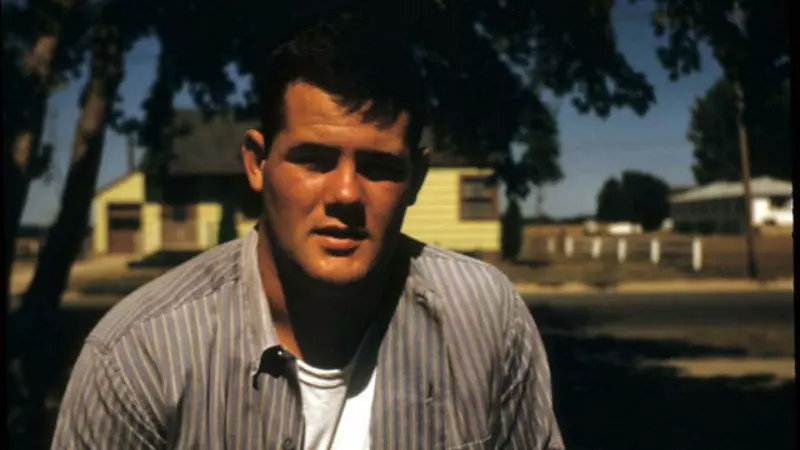
Dave Behrman and football…how good was he?
I was never an advocate of football and didn’t realize while growing up that he will forever be remembered as one of the greatest offensive tackles in Michigan State University football history. He was always big and as a 6-foot-4, 265-pound tackle he dominated opponents with his strength and quickness. MSU Head Coach, Duffy Daugherty, said that “If there is a college lineman anywhere with his speed, power, quickness, and intelligence, he has been well hidden.” Dave was an All-American pick in 1961 and 1962 and became part of the 1963 College All-Stars team that upset the NFL Champion Green Bay Packers, 20-17, on August 2, 1963 at Soldier Field in Chicago. After being distinguished as a first round draft pick in both the AFL and NFL, Dave’s AFL All-Star career with the Buffalo Bills and Denver Broncos ended in 1967 with back injuries. It was after that time period that he became a full time dad.
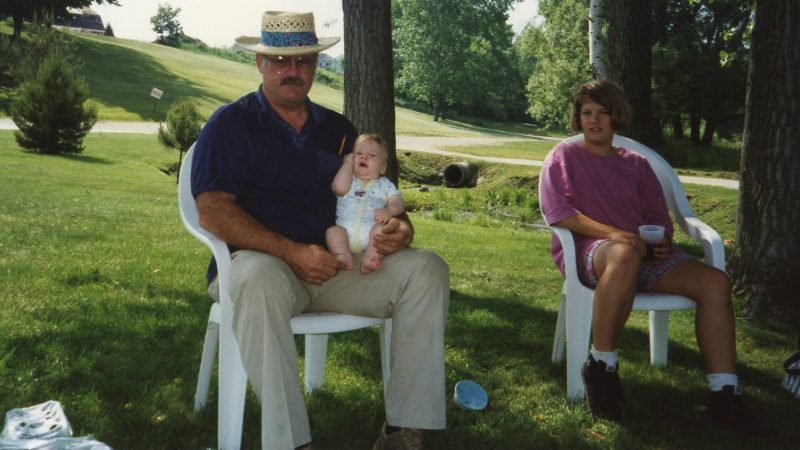
How do you remember your dad?
After football, he finished his business degree at Michigan State University and spent his career in the manufacturing and production environments in business and with the State of Michigan prison system tool and die shop. He loved tools and could make anything. He was a very intelligent man. At one point in my childhood my sister, Kellie, and I were wondering if he may have been one of those people who actually had a photographic memory, because he appeared to be able to retain everything he had ever read, learned or experienced. He also loved science and the value of scientific research, and I did too. He taught me that anything I ever needed to know could be found by researching it. At the same time, he taught me to pay attention to that pit in my gut, that feeling that you get when something isn’t quite right, and that the first thing that pops up might not be right, but it is the direction you go in seeking the answer.
Maybe that’s what caused him to be so good with “fixing” me. He worked with me before my ADHD diagnosis was available, without an owner’s manual, so to speak, by taking an interest in me, helping in what I was trying to do, helping to develop skills that I was good at. Since I learned by doing and not through lecture he would say, ‘don’t worry about mistakes, just make sure you learn something from them when you make them and try again.’ This is part of what motivates me today. His interest was always in what I was trying to accomplish. With my homework he simply read the chapter, looked at my assignment, and basically retaught me the lesson, one-on-one at the dining room table. Who knew just how effective that would actually be? This one-on-one fatherly touch continued when I was being punished for some teenage transgression. He would reconnect with me, alone, to discuss at length what happened, without judgement or anger, listening to me and even sharing his own personal experiences. All of those moments usually ended in some sort of agreement, often including a handshake, which I recognized as a contract that was in my best interest. And I honored every one.
Even as an adult today, one of my favorite early memories was a trip to grandma’s house and I realized that I had forgotten my baby blanket. We couldn’t go back because we had gone too far and I was not happy. My dad stopped at three stores along the way to grandma’s until we found a baby blue blanket with satin trim that made me happy. He was someone I knew I could count on.
All of this changed when the onset of his Chronic Traumatic Encephalopathy (CTE) began.

When did you notice that changes in him were taking place?
As he got older, his interest in his workshop at home helped him focus by being alone, just like the boating and fishing activities where he could retreat from the confusion of his mental decline and the conflict of a struggling marriage. As a natural introvert, with a talent in fixing and building things, he liked model boats and collected Karmann Ghias that he could repair and restore in his workshop. It was odd that he liked these tiny cars because he was so big and they were so small. Maybe the size of the cars represented the contradiction in his power and skill in football vs. his quiet, peaceful, and thoughtful demeanor as my dad.
Sadly, the depression, confusion, memory loss, lack of motivation, secretive behavior and balance issues, attributed to CTE, began to take over as he became more and more isolated. He lost the ability to maintain interest in friendships as well as being a devoted grandparent. We didn’t understand who he was becoming or what was happening. At times he was clear thinking in making a point and just as quickly he would lose all sense of logic and understanding of the truth. We reacted with anger, hurt and resentment and his behavior was hard on family relationships—because we didn’t know. As a result, we started professional medical support for him far too late. It wasn’t until we saw the Frontline Special, League of Denial: The NFL’s Concussion Crisis in October, 2013, that we began to understand what was happening to him, but the damage was done. When he died on December 9, 2014, he was diagnosed at the Boston University Medical Center for CTE with Stage III/IV CTE dementia.
How do you think about football as a result of your dad’s condition?
My dad never wanted my son, David, to play in the youth football programs in grade school. When he called me about the possibility of his playing, his advice was for David to pursue dog training or work related to animals. My dad didn’t eat, drink and sleep football like some athletes do—it wasn’t his passion. For me he was quiet, principled, shy and liked being by himself. It was sad to lose him to this disease (CTE). Knowing what I know now about my dad, I’m not so much in favor of football. I’ll admit that I don’t really understand the sport all that well and appreciate the fact that some people may disagree with my thinking.
© 2016, James Proebstle
John Bell
The College Years
Since 1950, Nebraska Football has honored one of its players each year with the Tom Novak Award for a player that “best exemplifies courage and determination beyond all odds in the manner of Nebraska All-American center, Tom “Train Wreck” Novak.” John Bell earned the Tom Novak award in 1973 for playing the game with intensity—reckless abandon as the coaches called it. Fighting through injuries and personal setbacks, John, #66, was tough and a critical part of Nebraska’s 1971 National Championship team, 1972 Orange Bowl championship team, and 1973 Cotton Bowl championship team. This was in addition to his mention on the All-Conference and All-American academic award roster and to John being a two-year letter winner on the Husker wrestling team. Middle guards don’t often get that level of notoriety. John was blessed with exceptional quickness and power as he leveraged his 202-pound body among interior linemen of a much larger stature.

Raising a Family and Building a Career
John was known to have a strong work ethic, working through his teen and college years. He obtained a teaching credential from Nebraska. Wanting to work with adolescents, he started as a youth counselor with the California Youth Authority detention system. Family priorities changed and a move closer to family took John to high school teaching and administration for the majority of his career. He loved working with kids and connected with them at all levels through a knack for good ideas and resourceful programs. His spontaneous nature for making things happen enriched many young peoples’ lives.
As children (Jared-son and Carrie-daughter), growing up with their father was always an adventure. He was always trying to introduce his children to new things and broaden their horizons. He challenged them every chance he got. He was at every game, every debate, every play, dance or choral recital, and every parent-teacher meeting. He was honest with his children and treated them with respect and listened whenever they had complaints and problems. Their communication was open and safe whether it be about sex, drugs or world events. John and his then-wife Paula divorced, and John insisted on joint and equal custody for his children in court.
He continued to include his children in his life even when he started dating his eventual second wife, Kathy. He always checked in with Jared and Carrie to make sure that they liked her. He even included the two kids on dates. John married Kathy in 1988 and they remained together until his death. Carrie and Jared were in the wedding and were also included on a family hiking trip/honeymoon—a “family-moon” long before it became trendy.
Carrie (Car-bear) and Jared (Jar-bear), as he called them, would attest to John’s level of enthusiasm via the many outdoor adventures and family trips as John’s reputation as papa-bear became legend. Until about 2007, Jared and Carrie would describe their dad was a bright shiny person. His Memorial Day parties were legendary. Their family and friends would gather. Everyone ate like kings, listened to music turned way up, and swam for hours. The kids were always going on road trips and encouraged to explore and try new things. He was firm and pushed the kids to their limits but was always kind and full of love and instruction. Carrie’s desire to see the world and live life fully were seeds planted by her dad. He also taught her how to be loyal and brave, to fight for the weak, and stand up to bullies. John was very proud of his kids.

As time went on, however, his lack of mobility and constant pain from arthritis restricted his need/desire to work out and remain physically active. The loss of this physicality in sports, which was so validating to John and so much a part of his youth, created issues. In his younger years, it was the physical contact inside and outside of wrestling and football that kept him focused.
John died on March 31, 2016, from a very aggressive onset of polyneuropathy, septic shock, coupled with complicating infections. The prognosis for recovery was not positive and after a week in ICU he was put on life support. Sadly, after two days of continued decline the family had to make the decision to take him off life support. Upon hearing of John’s passing many said that their lives would not be what they were today without John Bell. The family had just a small ceremony, but they received many cards, and Facebook posts in addition to the newspaper notice acknowledging John’s contributions.
Battling the Demons
John’s life was not easy, as his bi-polar II and ADHD diagnoses tormented him throughout adulthood. He just didn’t feel normal. Anger, irritability, binge drinking, hurtful comments, fault-finding, blaming, and rages triggered isolation. He often got very upset with friends and family and became disappointed with who they were. This led to negative comments as he would “just let them have it.” It was hard to recognize at times, and his kids internalized that this behavior was “not their father” and that he was not a “horrible person.” But it was painful to watch and also painful to be the brunt of the side effects. In an attempt to mask his demons, John’s risk-oriented personality lead him to more alcohol and recreational drugs. It was possible that the alcohol and drugs were a subliminal strategy to mask or suppress the undefined underlying medical issues. It was not a solution that worked and likely led to a psychotic break in his late 40s. Medication was prescribed but not always used.
His body wore down from the years of battle. With the loss of a physical outlet he turned to writing poetry and engaging in the arts more and more. But, as time passed the poetry became darker and darker and his trips to “outer space” went from once every six months to every couple of months. He would call his family several times a day at all hours of the day. He was always upset about things from the past, things that were unfinished or unresolved. Jared would sit and talk with him as much as he could. Sometimes John’s anger was directed at Jared for something he did or for not being there to answer his phone call. Most of the time he praised Jared for things he accomplished twenty years earlier or for the great father he was. He would end every call with, “love is love” and Jared responded with “not fade away.”

From their perspective, not being able to do as much physically made their dad grumpy and sad as he started cycling between being up and manic and down and depressed. He always had a fiery temper but it was easily provoked as he got older and deteriorated to where the littlest things would set him off. Maybe someone said the wrong thing or you slept in too late while visiting or weren’t ready to walk out the door the moment he was. Or, he would call within minutes of the last call and his messages would usually start nice and normal and then would get angrier. In the last few years he had left some pretty accusatory messages and would often call them names or swear at them. He started to act paranoid about how we were not being loyal enough or grateful enough.
John was not great at taking his bipolar medication because he didn’t like being “flattened out.” It wasn’t him, but then again neither was the person he was becoming. At a certain point we always wondered what dad we were going to get when the phone rang or when we went to visit. These rages within the family would lead Kathy to warn the kids that John was in “crazy land right now” and not to try to deal with him. Often, the events involved a very specific timeline that wasn’t honored and John would become unhinged. It was as if the unresolved details themselves would upset him. At times, John’s desire for closure would trigger an almost “stalking” response to get things settled. The many layers to the issues he was dealing with made productive employment unrealistic.
Kathy, John’s constant companion and soulmate, sought support in counseling, visits to AA and Kaiser with John, visits to Al Anon on her own and the loving support of friends and family to cope with the many challenges. Naturally, social contact with others disappeared with John’s difficult interpersonal issues.
Carrie and Jared struggled to reconcile the idea that they had grown up so loved and supported and with so much magic and fun only to see the last 20 years end with what seemed like a totally different person as a father. The family saw John’s great big smile less and less, heard that jolly uncontrollable laugh less and less.
In the last two years of his life John spent more time lost in his head than with the rest of his family. He and Kathy would come visit for a day to watch the grandkids play sports. But after a few hours, he would get antsy and was ready to go. He never seemed 100 percent at ease with his surroundings. It was like the man they grew up with was trapped inside. The changes happened slowly at first, but as time passed, the decline of the man his children had called dad sped up with every year. They would all agree that one day he was his normal self and then suddenly it seemed like a switch had been flipped and he had a different personality. With sadness, anger, and confusion as a forefront to his emotions—complications set in with continued self-medication with alcohol. His love for his family was never a question. It was always there, but sometimes residing too far down to be seen.

Donating John’s Brain
After seeing the movie, Concussion, it was Carrie that made the connection with John’s behavior issues and CTE. When we realized he wasn’t going to make it, Kathy contacted Boston University’s Chronic Traumatic Encephalopathy (CTE) Center, as well as Lisa McHale at the Concussion Legacy Foundation (CLF) to find out if they would take John’s brain after he died. Both Boston University and CLF were enormously helpful in their efforts and in time John was diagnosed with Stage III-IV CTE. With this diagnosis, the family achieved a sense of peace and forgiveness in having to take John off life support. There was a sense of reconciliation with the two dads whom they had come to experience. Part of what made it so hard for his family was that John had always been a pillar of strength and athleticism. He was rarely sick and he recovered quickly. He was always active, athletic and strong—in the end he was none of those things.

How has your attitude toward football changed?
Kathy remains steadfast in her support for football. She feels strongly that football provides an outlet or release for the aggression needs of many young men. The physical nature of the game, while not for everyone, is perfect for some. While her concussion awareness is much better today, she hangs onto the hope that the equipment will continue to become better and that testing of athletes will help improve the player safety aspect of the game. She is optimistic that we can become smarter and that the game will evolve.
Jared’s wife now worries about him with the eight concussions he experienced over his playing time.
Carrie feels that John’s story is important for people to read so they can understand that CTE can happen, even if the athlete did not play professional football in the NFL.
Love is Love…
Not Fade Away
Copyright © 2017, James Proebstle
Wes Bender
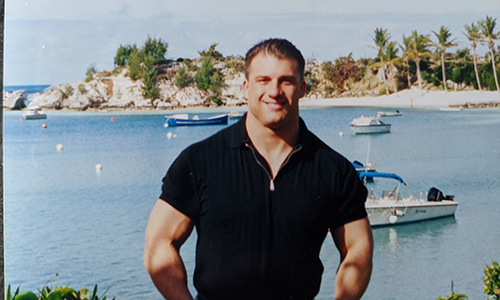
Wes Bender had a kind heart. He would take the time to speak with anyone and share his experiences and challenges.
Wes started playing Pop Warner at the age of six and was passionate about football. The very first time he took a handoff, he ran 80 yards for a touchdown. Wes was smaller than the average kid, but overcame that challenge with his speed.
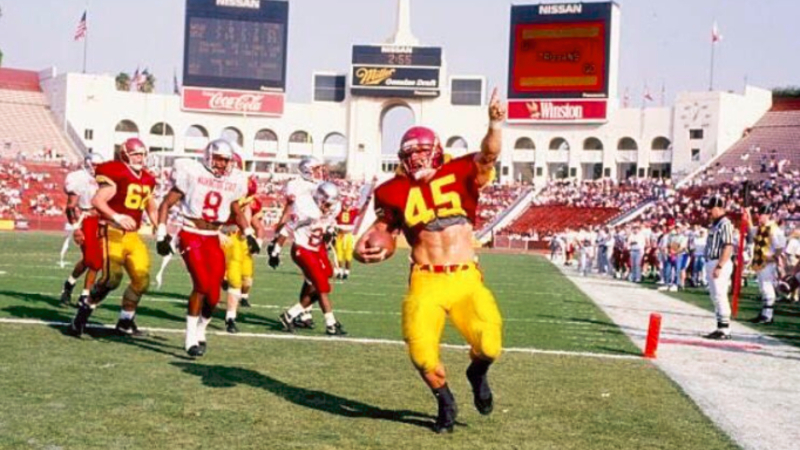
Wes was bright but sometimes his words and numbers were scrambled. His teachers, coaches, friends and family helped him until a key teacher recognized he had dyslexia. At the time, learning disorders like dyslexia weren’t common knowledge. Still, Wes overcame this challenge thanks to programs to help dyslexic students.
By the time high school rolled around Wes began to emerge with uncommon size, speed, strength, smarts, and competitiveness. The results? A powerful offensive running back who started as a freshman and sophomore at Burbank High School in southern California. But at the start of his junior year, the coaching staff wanted to move Wes to the offensive line. The proposed switch challenged his dream of being a college running back so he transferred schools to the cross-town rival, John Burroughs High.
Wes’ transfer to John Burroughs produced one of the most productive high school offenses in Southern California history. Against his old team, Wes scored a 50-yard touchdown run in a 41-0 victory. Wes’ success led to his induction into the John Burroughs Hall of Fame in 2015.
Dyslexia made it difficult for Wes to learn a foreign language, a college requirement. Many colleges were interested and offered scholarships, so he attended Glendale Junior College to refine his skills. Wes went on to set several Glendale College records and lead his team to win the Western State Conference title. His time at Glendale earned him a full athletic scholarship to play for the only college he would consider, the University of Southern California.
Wes started for two years at USC and set several weightlifting strength records that still stand posted in the weight room today. Wes was a powerful, hard-hitting fullback, routinely stuffing linebackers at full speed, blocking players in the open field, knocking them to the ground, and creating holes for the tailbacks to follow.
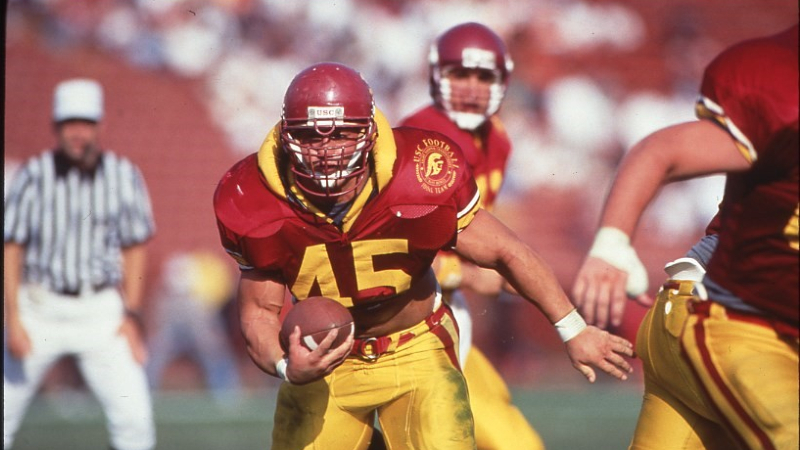
Mazio Royster was the tailback who benefitted from Wes’ blocks at USC.
“Wes was a great teammate, but an even better person,” Royster said. “It was my job as the tailback to read the fullback’s block. These were some of the most violent collisions imaginable and Wes never shied away from contact, complained, or even asked for praise.”
Wes’ incredible blocking earned him a shot in the NFL. Marty Schottenheimer, then head coach of the Kansas City Chiefs, said Wes was one of the best blocking running backs he had ever seen come out college.
Wes accomplished his dream to play in the NFL with the Chiefs. Wes earned the nickname “Fender Bender,” delivering crushing hits, knocking out All-Pros and Hall of Famers while team members would joke and tell him to tone it down a bit. An ankle injury sidelined him that year, leading him to his hometown Los Angeles Raiders. Wes was referred to as “Bam Bam” with the Raiders, receiving game balls and Monday night honors until he moved to the New Orleans Saints two years later.
New Orleans was Wes’ final stop in the NFL. He played for the “Coach” Mike Ditka. Coach Ditka preached tough, hard-hitting football. Wes was at home in New Orleans, winning more game balls, and creating key plays with his blocking.
Wes’ position and style of play led to countless head impacts. He suffered a reported 23 concussions in his football career. He retired from the NFL in 1997.
The football chapter of Wes’ life was closed, opening the door to the business world. Wes always loved to modify cars and trucks, so he started a successful business building modified four-wheel drives and other auto specialties. Wes was very good with people, had a kind heart and would chat with anyone. One of his clients thought he might enjoy the sales and service elements of the concrete business.
Wes was very successful running large concrete jobs in Los Angeles, but some things in his life were not clicking fully. Sleep became more challenging, as Wes would wake up frequently at night. He became overwhelmingly stressed by simple things most people can cope with easily. The concrete business was very competitive, stressful, and becoming too much for Wes, so he decided to retire from that business due to health concerns.
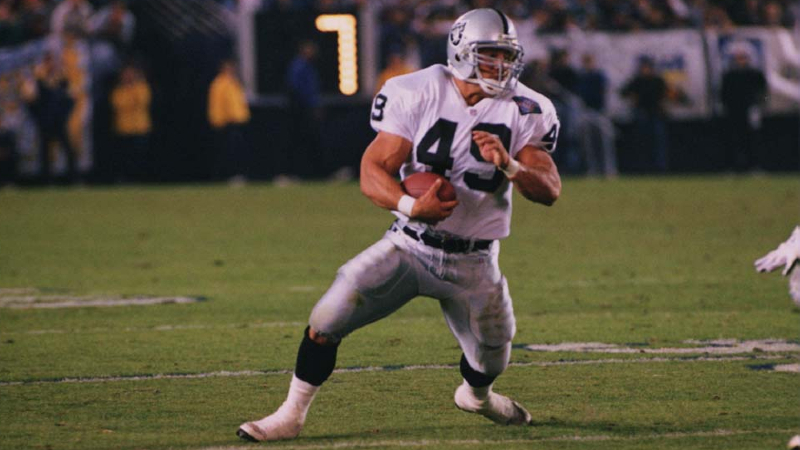
The final chapter was starting a business with family in the medical and dental industry. This was perfect, helping the business get started at his Alma Mater USC and crosstown rival UCLA. The UCLA dental program loved Wes, despite him being a USC alum.
Wes could always make you laugh and could remember movie lines from 30 years ago or jokes from childhood. But he strangely couldn’t remember what he had for dinner the night before, or a conversation he had with a salesperson a week ago about training.
“What was going on?” we’d ask Wes.
Wes would get frustrated and say, “I just can’t remember.”
Simple tasks, things most people don’t think about became a challenge. Wes would run to the store to get milk and then forget why he went to the store.
My brother Wes passed away in his sleep on March 5, 2018 at age 47. The stress of his life was too much for his heart and his brain.
Four months before his death, Wes completed his will and stated his intention for his brain to be studied at the UNITE Brain Bank in Boston. At the time, we thought this was an interesting decision, but we followed his request and sent his brain to the Brain Bank.
There, researchers diagnosed Wes with Stage 2 (of 4) Chronic Traumatic Encephalopathy (CTE). We didn’t know it at the time, but Wes’ intuition about his brain was correct.